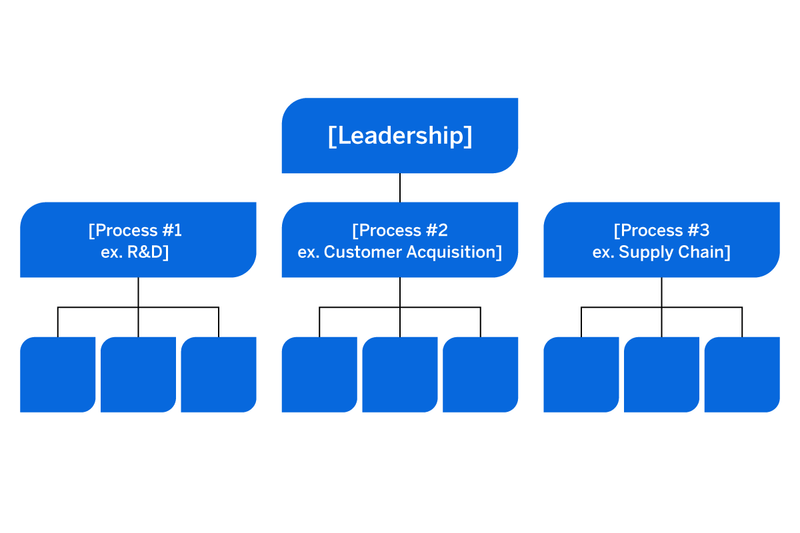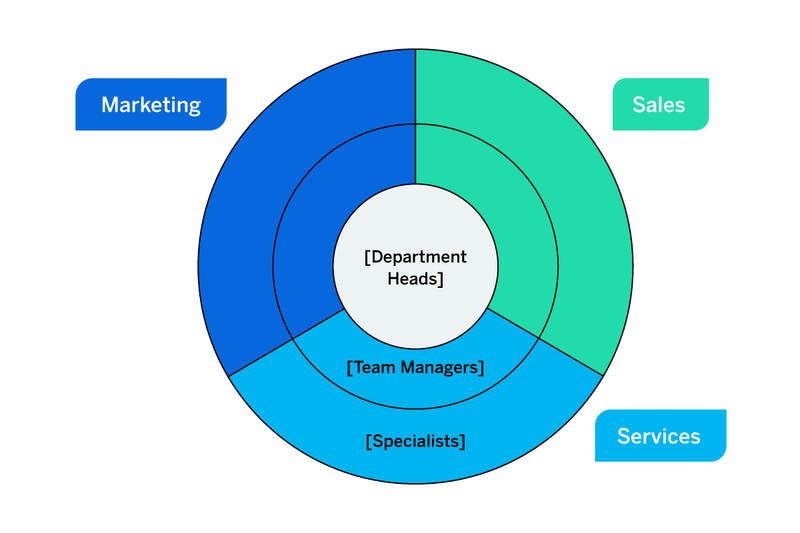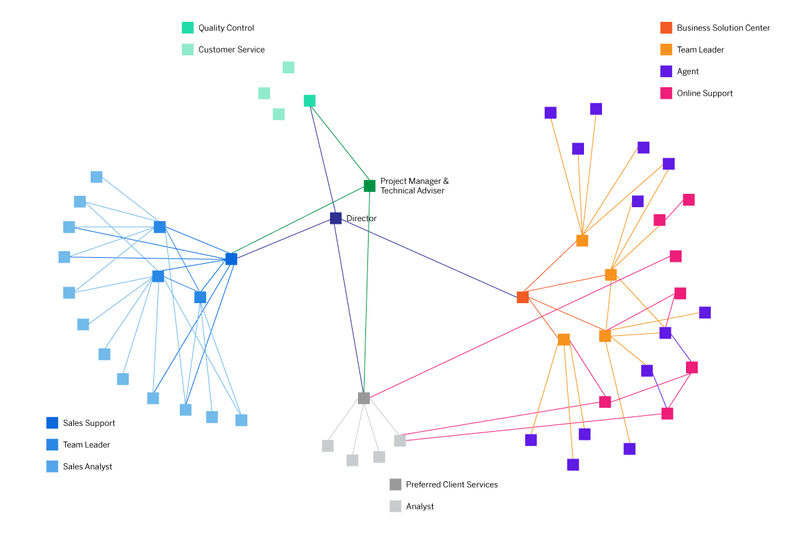Every organization has a structure that directs how employees are managed and ordered. There are four main organizational structures that every leader needs to know about. Let’s explore the advantages and disadvantages of each in more detail.
What is organizational structure?
All organizations are formed of different elements like, for example, markets, functions, products, geographies, or processes.
An organizational structure visualizes these elements into a diagram that helps explain how these elements fit together as a whole, in order to meet an organizational goal.
If someone wants to understand what an organization does, what it is made up of or how it operates, they may look at an organizational structure to see the details.
Crucially, it describes the placement of people and how they interact. The way an organizational structure is formed, tells you a number of things:
- What employees do: the employee’s roles, responsibilities, and tasks, and how these are allocated.
- The direct reporting relationship: How is the employee supervised and who do they report to? The higher up the chain an employee is positioned, the more authority and impact they can have.
- Who are in positions of power: Based on the organizational structure, you can understand which employees coordinate the activities, who can make decisions, and who is impacted as a result of these decisions.
- The direction of information flow: In which direction does information flow – top to bottom? Bottom to top?
There are five types of organizational structures that we’ll be exploring: functional structures, flatarchy structures, matrix structures, divisional structures, and circular structures.
Free eBook: Designing a world-class EX program that attracts and retains talent
How organizational structures affect the employee experience
In having an established organizational structure, leaders and managers can see at a glance the human influence over an individual employee, a team, a whole department, or a whole area of the company.
This can be a very important tool for understanding how employees are impacted by the organization’s setup, which can help you improve the overall employee experience.
For example, an employee that feels unhappy may attribute their situation to feeling stifled by their place in their team or unable to make decisions that affect their work-life balance.
Employee experience is the employee’s understanding of their work environment and how this impacts them positively or negatively.
In this way, an org structure can be seen as a window to how an individual employee views their environment. Using the example above, how empowered they are to make decisions could be directly related to where they sit in the organizational structure.
Getting the environment and organizational structure right is therefore important to keep employee experience high, which has these benefits:
- Improved employee performance: SHRM research shows that most employees that are engaged in their work are more likely to help the company achieve its goals.
- Lower attrition rate: According to the Oxford Handbook of Positive Psychology at Work, engaging employees means 87% are less likely to leave their organization, meaning reduced turnover costs to the company. To replace skilled employees, management needs to recruit new staff, train them, and wait for them to ramp up to full productivity.
- Increased revenue: According to Gallup, high team and employee engagement contributes to 21% greater profitability. Motivated employees who score in the top 20% in engagement are linked to a 41% reduction in absenteeism and 59% less attrition.
- A better customer experience: The same Gallup study found that high employee engagement contributes to a 10% increase in customer ratings and a 20% increase in sales.
Benefits of organizational structures
What are the benefits of having an organizational structure set up in your business?
- Helps your organization adapt: Flexible organizational structures are better at adapting and staying competitive as the market changes.
- Defined decision-makers: if decision-makers in the chain of command are predefined and acknowledged, then when decisions need to be made, they are made and adopted faster.
- Consistent management practices across locations: If you have multiple locations, having a consistent organizational structure can help others know what to expect in every location.
- Scalable: As organizations scale up, the structure can be added to or stretched out to follow suit.
- Helps manage financial admin: This can also help leaders understand which levels of employees are at what pay scales, according to their responsibilities.
- Employees gain a sense of purpose and place: An employee can understand their role, actions, and responsibilities, because it is clearly laid out in an organizational structure. This can make getting onboarded and getting to work quicker as each employee understands their place in the organization.
- Work output is clearer and more efficient: If employees know what they’re responsible for, then there is no risk of wasted effort, duplicated work, or overlapping responsibilities. This means that time is spent only on what employees need to focus on and so work output is faster.
- There are clearer boundaries between roles: By defining employees into sections or teams according to organizational goals, there is less conflict towards that aim. It’s also clear who can do what, and who you can go to if you don’t know what to do.
When would you consider creating an organizational structure?
You could implement an organizational structure for many reasons:
- There is a problem and you want to refocus the organization to solve that problem: For example, if sales aren’t performing and you traditionally focus on splitting sales functions across different product lines, drawing all salespeople together into a departmental organization structure can help refocus all sales people onto the same goal.
- At times of company change: This could be because of a merger, acquisition, or a rethink about how you want to proceed with a new product or into a new market.
- At time of market change: As with the pandemic, the way customers and the market reacted changed how companies needed to respond. An organizational structure can help clarify what gaps in employee needs there are.
- To handle internal operations efficiently: If you find some people have a lot of direct reports or someone senior in the chain of command has left, and organizational structure can help you understand the impact and best way to proceed. This is also useful when you want to scale up or downsize.
Centralized vs decentralized organizational structures
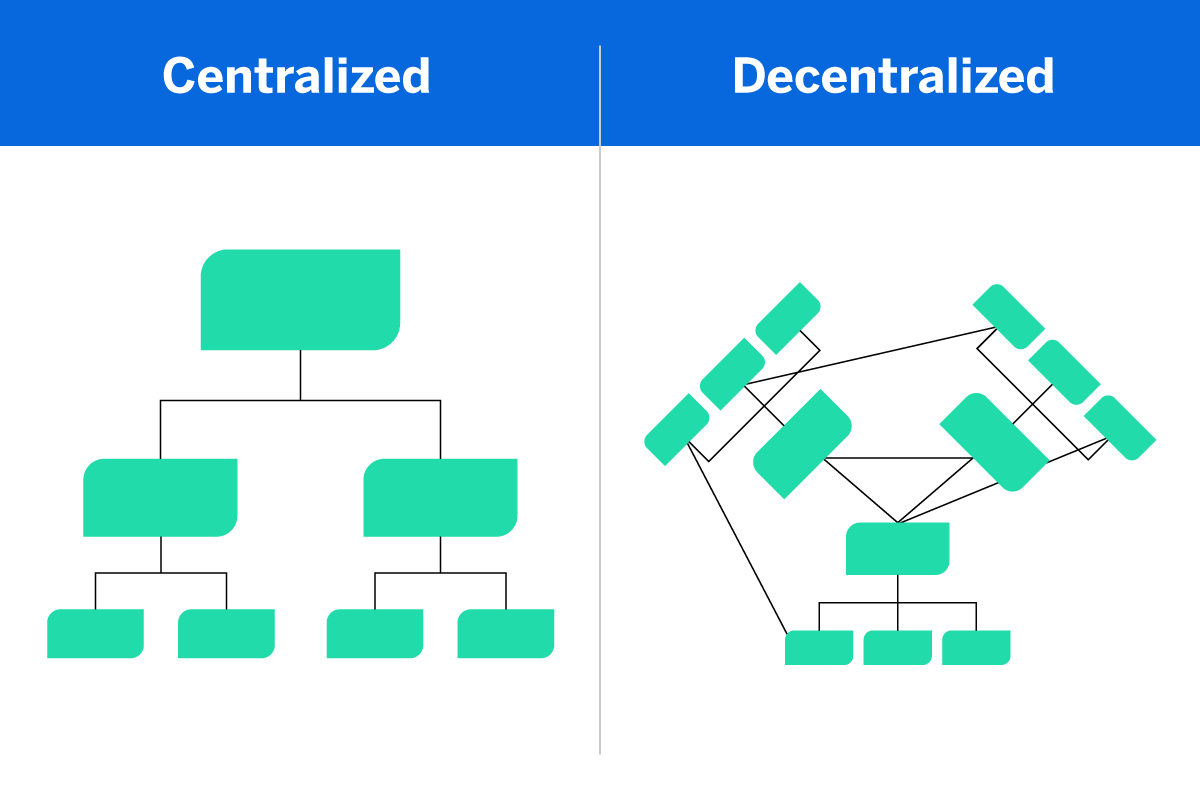
It’s important at this stage to understand that there are two kinds of organizational structures to be aware of: centralized and decentralized.
Centralized organizations
Centralized organizations are structured with a central point of leadership and information usually flows from this point of command down to all other employees.
Centralized organizations are also known as mechanistic, as they resemble a mechanism that has lots of parts that all work together at different levels of importance, yet in tight formation to achieve a goal.
These are also called bureaucratic structures as well, as there is a defined control point that then defines each employee’s role and level of authority in a rigid way.
Pros:
- Staff know their role
- Chain of command authority is well defined
- Decisions are taken by a few employees to impact many employees
- Helpful when just starting out
Cons:
- There is a lack of creativity and innovation as roles and work is so rigid
- This kind of structure can be hard to adapt to market changes quickly
- Progression can be based on an employee’s ability to surrender, comply and curry favor.
- The top key employees in power have a lot of responsibility and strain on them
Decentralized organizations
On the other side are decentralized organizations, which are looser on authority chains and allow for informal authority relationships across different areas.
Also known as organic and flat structures, people are free to work across tasks and areas, and work responses are according to need or requirement at the time.
Pros:
- Employees can use their initiative and innovate to do work
- Less friction when adapting to fast-changing market conditions
- Decisions can be made more democratically
Cons:
- Employees may have to do more, which could lead to burnout
- Employees may not know where to prioritize efforts.
- There may be fewer places to turn to if there are key decisions to be made
Four types of organizational structures
Functional structure
A functional organizational structure occurs where the company is split into specialization, based on the function of the teams.
For example, there can be specific teams for marketing or sales functions, which have common sets of roles and responsibilities.
There is a centralized point of authority, which can range from managers to leaders. Then each function has its own management lead. Levels of responsibility travel downwards through the organizational hierarchy.
Pros:
- People with the same role and skills are grouped together to provide consistent and targeted activities towards the aim of the function.
- There is a stronger team that works together
- Employees know what they need to do and can focus on work
- Functions can scale easily
Cons:
- Hard to work across functions that have differing goals and aims.
- The company can feel siloed into different groups.
- A lot of pressure on managers to manage large groups of employees.
Matrix structure
A matrix organizational structure is where teams are cross-functional and employees can report to more than one manager or leader.
For example, one employee can belong to the marketing function doing one function (email marketing), but also be involved in product engagement work as well (product content creation). Their work is reviewed by two different function leads.
Employees working for companies using the matrix structure have the potential to widen their skill set since they might be assigned to various projects requiring different levels of expertise or skills.
Pros:
- Employee skills are shared across functions and this improves cross-team coordination and cooperation
- Provides the company with flexible resources when needed
- The needs of the work are prioritized and employees are chosen to assist with these
- Can give employees variety of work and experience
Cons:
- Employees can be drained working across projects
- Employees may not know which work takes priority
- There can be conflicts in management style and authority
- Work may not get done efficiently, which can be costly
- The management of a matrix organizational structure is complicated
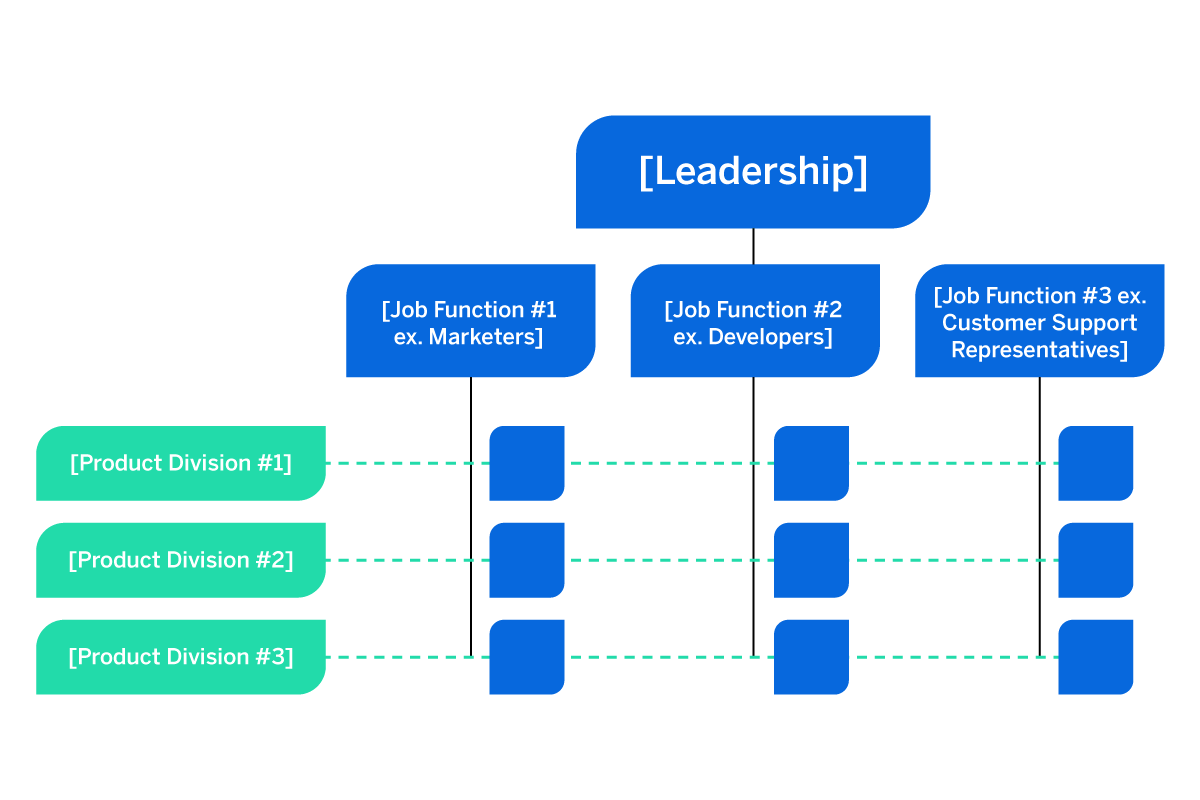
Divisional structure
A divisional organizational structure, also known as a multidivisional structure, is made up of divisions that each have their own functional structures.
For example, a company can have three divisions, which all have their own internal functions of IT, sales, and marketing teams.
Management of each division has a lot of authority to make business decisions, based on the needs of their division.
There is a common goal that the division is working towards, based on the organizational goals.
Pros:
- There is strong divisional leadership, which has independence over activities.
- Each division can be flexible based on its own goals and needs
- Each division can respond to changing market needs
Cons:
- Divisions may compete against each other, creating conflict or lack of communication internally.
- There may be more similar roles in functions, across all divisions, so there may be more than necessary numbers of employees hired.
Depending on your organization’s focus, there are a few variations to consider.
Product-based divisional – divisions are separated by product line, so resources can individually look at how to boost product lines.
Pros:
- Helps each product line get its own focus and activity
- Easily scalable as new product lines are added
Cons:
- Duplicate resources mean more employees may be hired than needed.
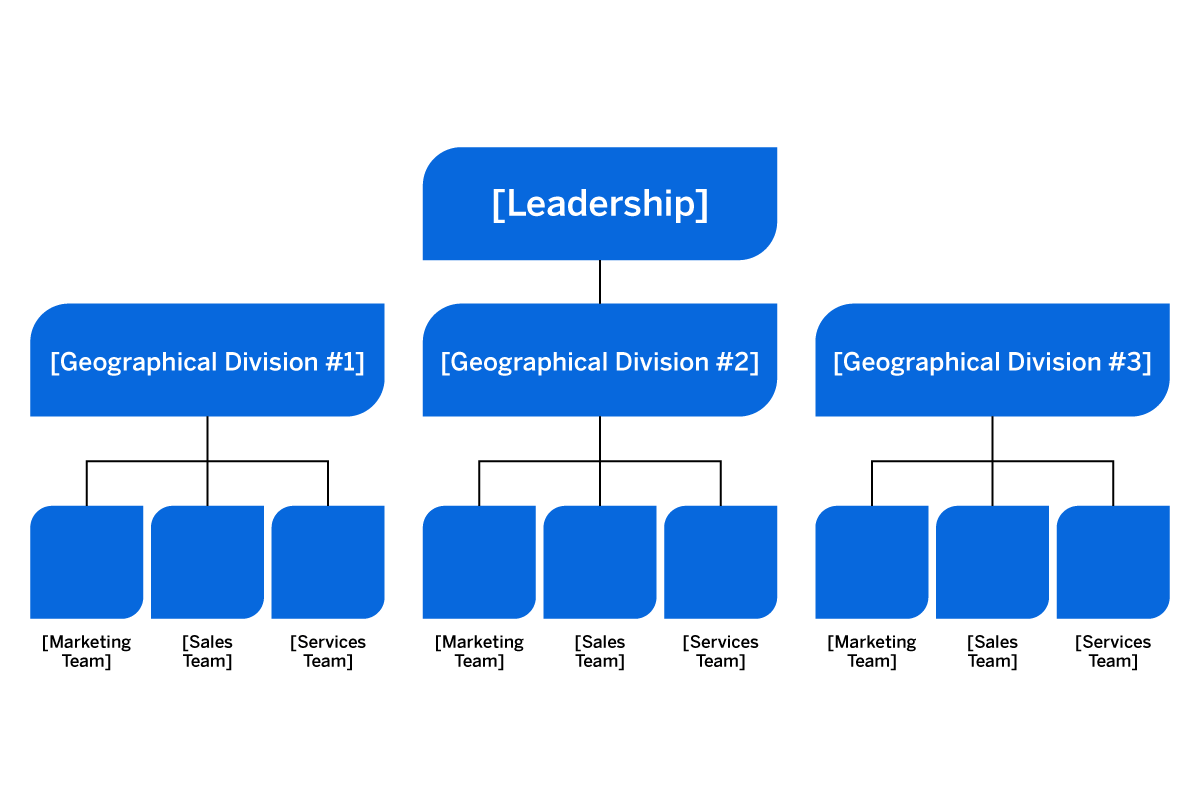
Market-based divisional – divisions are separated by markets, so resources can individually look at how to work in different markets or industries.
Pros:
- This gives dedicated resources to understanding each marketplace, which can help make selling easier
- Can help make entering a new market easier if there is a structure that caters to all functions
Cons:
- Duplicate resources mean more employees may be hired than needed.
- Issues when markets conflict or overlap, could lead to mixed messaging.
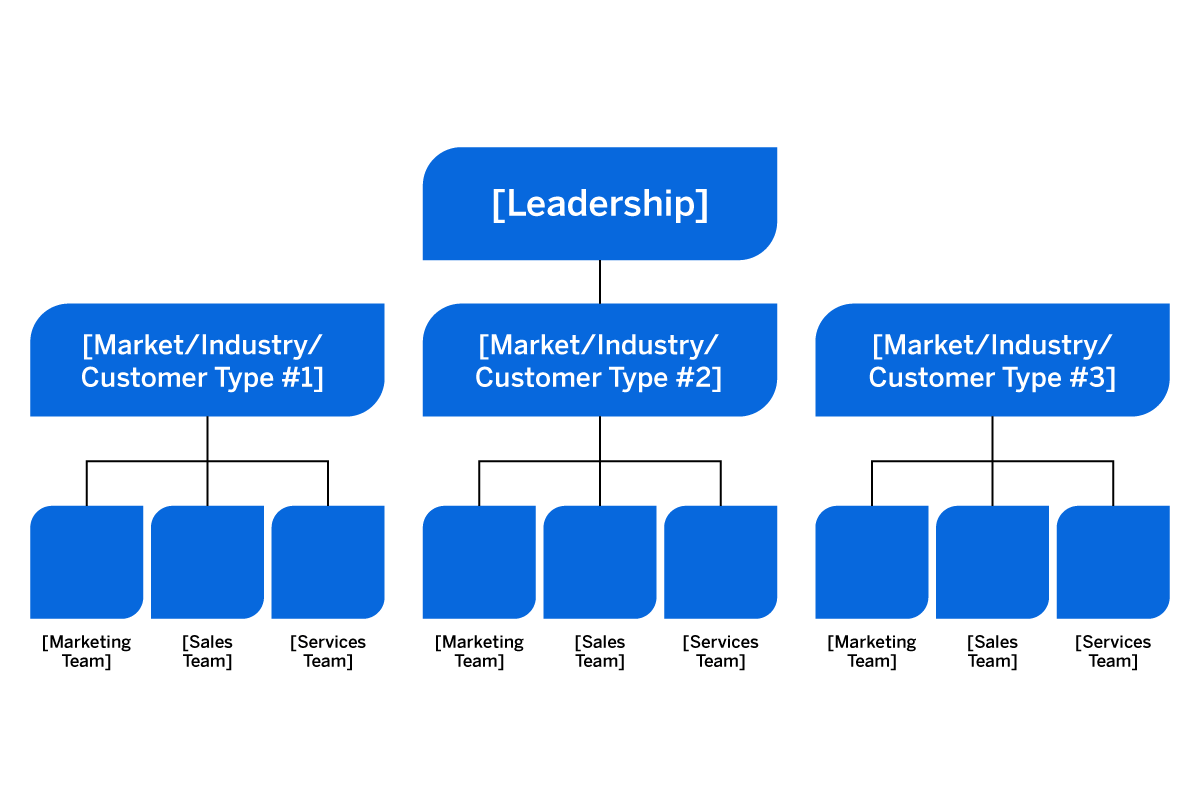
Geographic divisional – divisions are separated by geographical order, so resources can individually look at each geographical area in turn.
Pros:
- This can cater towards the language requirements for each geography, making functions work more efficiently
- Looking at geographic regions and areas can make key messaging more targeted and appropriate to the local customers.
Cons:
- Duplicate resources mean more employees may be hired than needed.
- Decentralized management makes decision-making risky and the company may end up competing with itself.
- Each geography may have unstable or negative working environments that can hinder progress, e.g. if a target market is at war or dealing with unstable government shifts.

Process-based divisional – divisions are separated by process order, so resources can individually look at each process area in turn.
For example, process-based divisions can be based on stages in product development, like research, product design, sales, and so on.
Pros:
- Maximizes the earlier process actions and makes operations efficient, so that the latter process stages can be used in turn at a quicker rate.
- Leaders think about the company divisions as a whole, seeing where each division is placed and how it impacts others in the process.
- Leads to great communication and productivity between divisions.
Cons:
- Duplicate resources mean more employees may be hired than needed.
- Where there are process hold-ups, there is pressure on the division to resolve the issue fast.
Flatarchy structure
Flatarchy is an organizational structure that flattens the way that authority and tasks are assigned, by removing upwards management levels.
These structures enable all employees to be involved in various teams and tasks that help achieve the organization’s goals.
Pros:
- Work can be carried out quickly for real-time ideas implementation
- Employees have greater control over their decision making and tasks
- Communication is key to getting work done and coordinating efforts
- Employees have a lot of responsibility and gain a lot of experience
- Employees feel like equals with leader
Cons:
- If there are no leadership levels, then there is strain on the sole leader and this can lead to conflict with decision making.
- As the company grows, a flat structure is harder to manage and maintain
- As there is no management oversight, employees may be focussing on the wrong activities.
- If there are complicated situations, the unstructured flat system will struggle to cope effectively.
Circular structure
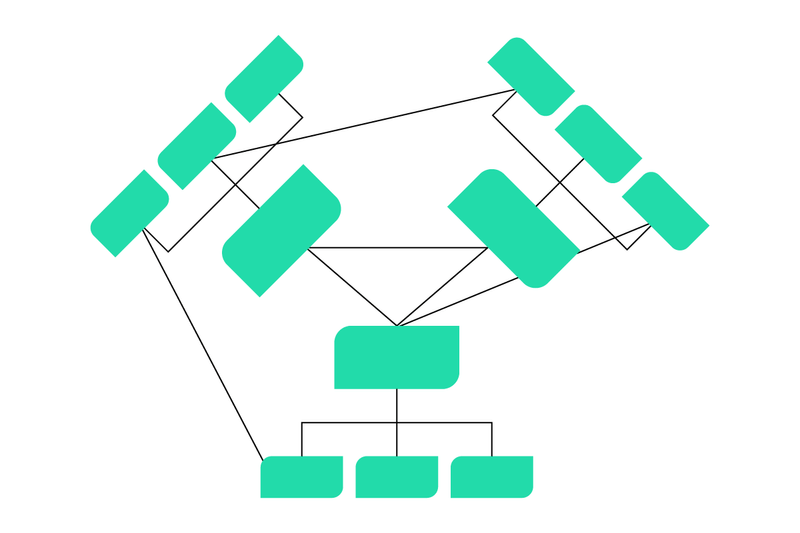
A circular structure works with leaders and department heads having access to all managers a level down, across all functions. This helps senior leaders join up the activities across functions.
Having a circular structure means that senior managers and leaders start at the center and their authority spans outwards, with employees receiving it at the lower levels of the circle (the outskirts).
Pros:
- The same management are able to connect with all functions and employees across the company
- Communication flows from the inside out. This can mean waves of information to all functions at the same time, which provides consistent messaging.
Cons:
- The leaders have a lot of responsibility as the sole authorities
- Having the same management in charge can be confusing for lower-level employees to understand who they report to or can discuss issues with
Network structure
A network structure looks at the full network of employees, irrespective of whether they’re part of the company or not. This usually takes into account all freelancers, services, and third parties that are needed for the company to function.
Pros:
- This provides an accurate view of the working parts of a company, from within and outside of the organization.
- This can help identify where extra staff or support is needed, or where work can be better served by exchanging external support for an in-house role.
Cons:
- It can be complicated, especially if the network relationships aren’t accessible by all employees, or if there are overlapping external resources across several teams.
Choosing the right organizational structure for employee experience
These organizational structures can be used by businesses to help define their hierarchy and support their business goals. However, it’s hard to know which is the right one for you. There’s no clear cut answer, but there are a few things that may help.
What is your business objective?
If your company is keen to improve every section of their department for the best optimal performance, you might want to explore a process-based divisional structure or a functional structure that has high levels of authority to guide important changes into each area. A more controlled area is easier to change or review for performance.
However, if your business goal is to build a company where innovation and ideas generation are key, having a flatarchy or a matrix style structure, that prioritizes having more of a say or free movement of employees across departments. This can help achieve your goal.
Explore what your goal is, your ideal working scenario and outputs, and see which structure might support that vision.
What organizational structures are similar companies using?
There are many companies that are using organizational structures, which can be a model for you to consider.
For example, divisional structures are more useful with larger companies that have multiple offices across the world, multiple markets to enter, and products they cater for. This allows for more autonomy by the division, which can help management to spread the management load.
Flat structures might be useful in a startup business, where each employee is doing a lot of activities and working together to get things off the ground.
Companies that are small and medium-sized may benefit from functional structures that help define roles and authority chains of commands.
What are the current weaknesses or problems you’re facing?
If you recognize that your business functions aren’t communicating or there are silos, then this could be a weakness in sharing messages and avoiding duplicate activities.
Explore what isn’t working or where ideally you’d like to take the organization and choose your organizational structure to support changes that would help your problem.
How fast does your organization plan to grow or adapt?
Flexibility is a key consideration as your business evolves. If you’re able to adapt to your customers, markets, competitors, and your own goals, you can be agile and outperform lesser organized businesses.
Maybe a decentralized organization structure, like a flat structure, might help your employees react faster to changes and communicate quicker without hierarchy boundaries?
Or is a centralized organization structure still needed for clarity and order, but you might need to consider how to improve your internal communications processes or technology?
You may have to make do and experiment sometimes. When the pandemic changed consumer behavior and shifted the focus to digital services, companies had to adjust and apply the structures innovatively.
Ways to help your organizational structure improve your employee experience
Don’t forget the importance of employee experience during this time. This is important in these scenarios:
- Communicating the changes: Whether you’re just at the start of the journey, or you’re committed to changing or redesigning your organizational structure, communication and listening are key. How do the changes impact the employees and how can you effectively share this information? A company-wide set of announcements, opinion polls, and real-time analytics on the results would be useful in gaining actionable insights, reassuring employees, and making employees feel heard.
- What will the changes mean for an employee’s future prospects: If you change the organizational structure, is it harder or easier for employees to make changes, get a pay raise, rise up the ranks, or get noticed? If certain employees are affected, they may decide to find another company or be at risk of being poached by competitors. This can impact attrition rates, employee morale levels, and your ability to continue being productive.
- The impact your employees can have on others: Your employees are internal and external ambassadors for your brand to customers and potential new recruits. Help them recommend your company by treating them with respect, keeping them included, and showing them the benefits of a new structure. They’ll become the model employees of the future.
To help you keep employee experience front and center of mind when improving your organizational structure, we’ve developed and validated a more modern view of employee experience. This helps make the employee experience easier to understand and act on.
How does it work? Our in-house team of organizational psychologists identified 5 key KPIs to measure EX:
- Engagement: The relationship and support from the manager
- Intent to Stay: The company culture that attracts people to stay
- Engagement: How engaged the employees find their roles
- Inclusion: How involved and included they felt in their teams
- Well-being: How does the company encourage employees to focus on their health
And there are 25 drivers that influence them, which come together as a framework called EX25, an industry-leading holistic approach to measuring and optimizing employee experience:
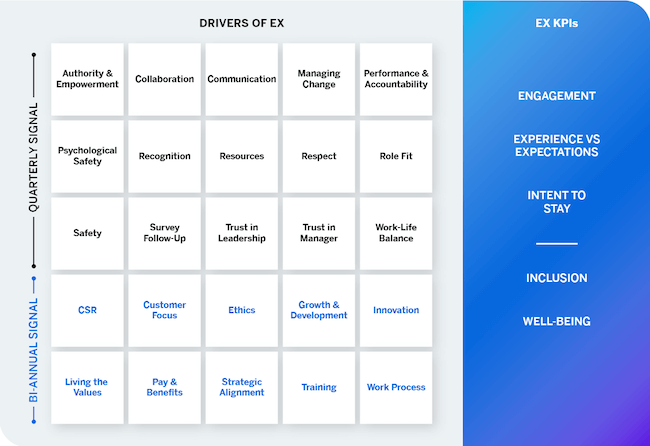
With EX25, management can holistically understand employee experience and where to focus and lead employees in order to drive impact. It’s crucial to know as you make more changes to the organizational structures and to the future of your company.
Learn more about EX25 and how to encourage top talent by downloading our Ebook.
Free eBook: Designing a world-class EX program that attracts and retains talent
